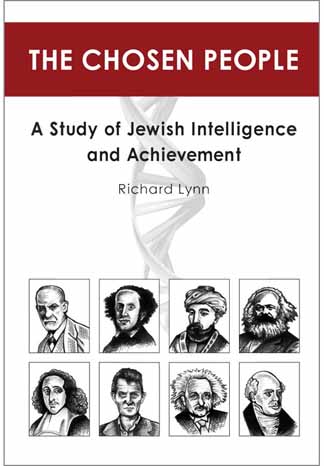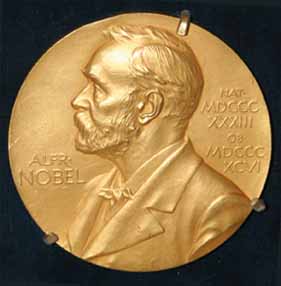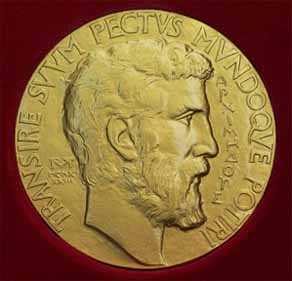The Chosen People
Byron M. Roth, American Renaissance, November 2011
Richard Lynn, The Chosen People: A Study of Jewish Intelligence and Achievement, Washington Summit Publishers, 2011, 408 pp.

The Chosen People: A study of Jewish Intelligence and Achievement is the most recent work of Richard Lynn dealing with group differences in IQ and their ramifications. As in all of his previous work over the past decade, he substantiates his arguments with huge quantities of empirical data. He advances his positions dispassionately and lets the facts speak for themselves, which they do in impressive, nearly irrefutable fashion. In his previous books he examined racial and ethnic differences in IQ for many groups. The Chosen People is a case study of one distinct group that has shown remarkably similar patterns of achievement in a wide variety of settings.
Professor Lynn begins by pointing out the extraordinary success of Jews in almost every field. In the 19th century the restrictions that had prevented most Jews from advanced nonreligious study began to be lifted in most of Western Europe, and by mid-century, “people began to observe that Jews were outstandingly successful, and began to speculate that this was attributable to their intellect.” (Unless otherwise noted, all quotations are from Professor Lynn.)
At that time the great bulk of Jews were still living in Eastern Europe, but owing to pogroms beginning around 1880, Jews began migrating to Western Europe and especially to the United States. They formed part of the massive immigration to the US in the period from 1880 to 1924.
Prof. Lynn writes:
They arrived as penniless refugees unable to speak the languages of their new countries; they were the “huddled masses” from the most backward region of Europe. Yet by the middle decades of the 20th century, the children and grandchildren of these immigrants were doing far better than their Gentile hosts on all indices of socioeconomic status and earnings and outperforming them by several orders of magnitude in obtaining elite academic distinction . . . .
The development of IQ tests confirmed the impression that Jews were unusually intelligent, and Professor Lynn’s extensive review of the literature indicates that Jews in the US have an average IQ of 110 compared to 100 for other Europeans. This would help account for their outstanding performance in a variety of fields. Though Jews are only about 0.2 percent of the world population, half the world’s chess grandmasters, for example, and 16 percent of Nobel Prize winners for science have been Jews. For Professor Lynn, the purpose of his book “is to document and explain such achievements.” It would be a mistake to think that these are the accomplishments of all Jews, however, as they are mainly the achievements of Ashkenazi Jews, the Jews of Eastern Europe.
Professor Lynn explains that there are four major subpopulations of Jews, differentiated genetically by their different experiences following their expulsion from Israel in the first century AD. The most populous group, by far, are the Ashkenazi, who migrated to Western Europe. However, “In the period between 1290 and 1500, Jews were extensively persecuted and expelled from Western and Central Europe . . . . Most of them migrated eastward into present-day Poland, Lithuania, Latvia and Russia.” There they remained until the mass migrations of the late 19th and early 20th centuries. Those who stayed were, in the main, killed by the Nazis toward the end of World War II. Most of those who survived the war migrated to Israel and other, mainly English-speaking countries.
A second group, the Sephardim, migrated to the Iberian Peninsula after the Roman expulsion, where they lived, largely under Muslim rule, until 1492. Jews flourished during the early period of Muslim rule, but from about 1000, a change in Muslim leadership led to increased persecution. When Spain drove out the Muslims in 1492, it also expelled all Jews who refused to convert to Christianity. Portugal expelled its Jews in 1496. Most Iberian Jews then went to the Balkans, though others migrated to the Middle East, the Netherlands, and Italy. Prof. Lynn notes that “their descendants in the mid-20th century numbered about two million and were widely dispersed throughout the world.”
A third Jewish group, the Mizrahim, settled in various lands in the Middle East and North Africa during various diasporas beginning about 600 BC. These lands were conquered by the Arabs in the 8th century, under whose rule Jews were tolerated but subject to various restrictions. This area was conquered in the 16th century by the Ottoman Turks, who “provided a generally benign environment for Jews and other non-Muslims.” That is the main reason why Jews expelled from Spain and Portugal made their way into the Ottoman Empire.
A fourth group, the Falashas, “are Ethiopians who converted to Judaism at some uncertain time many centuries ago.” The state of Israel recognized these genetically distinct Africans as Jews who were, therefore, entitled to take advantage of the Jewish Right of Return. Prof. Lynn writes that “by 1998, virtually all of them had left Ethiopia and taken up residence in Israel. They numbered about 80,000 . . . [or] about 1.4 percent of the population of Israel.”
With the exception of the Ethiopians, the three Jewish subpopulations greatly resemble each other genetically and are distinguishable from Gentiles. Nevertheless, centuries of separation produced considerable differences among them, due in part to intermarriage with Gentiles, even in the face of strict endogamy rules.
The most notable difference among Jewish groups is average IQ. While the Ashkenazi average is 110, the Sephardic average is about 99, close to that of Europeans. The Mizrahim score about 91, markedly lower than Europeans, but higher than the Arabs with whom they have lived, whose average is about 84. The genetically distinct Falashas have IQs of about 70, typical of sub-Saharan people.
These IQ differences have had an important impact on the achievement of each group. This is especially clear in Israel, where they live side by side. The Israeli population of about 6 million people (in 2000) is about 40 percent Mizrahim, about 40 percent “European,” and about 20 percent Arab Muslims. Comparisons are complicated, however, because the 2.4 million characterized as European include 110,000 Sephardim. Furthermore, many in the group classified as European Jews are immigrants from Russia, a large number of whom — some Israeli demographers estimate as many as 900,000 — are not Jews at all. They are ethnic Russians “who pretended to be Jews in order to obtain permission to leave the Soviet Union.” For these reasons the average IQ of those classified as European Jews is estimated to be about 106, lower than would be the case if all were Ashkenazim.
Nevertheless, on all measures of social and educational success, the Europeans do better than the Mizrahim, who in turn do better than the Arab citizens, a ranking perfectly consistent with IQ estimates. Of particular interest are the Ethiopians, who do very poorly, and behave like American blacks. According to an Israeli researcher, many “identify with an ‘aggressive and semi-criminal African-American youth culture’ and have become a ‘kind of ethnic underclass.’ ”

Ship’s manifest of immigrants, Ellis Island, 1901: those from Russia are Jews.
The largest portion of Prof. Lynn’s book deals with the performance of Jews (mainly Ashkenazim) in just about every country in which they settled. The most striking finding is the very great similarity of Jewish achievement everywhere. Without exception, Jews outperform their non-Jewish neighbors by very large multiples. Whether in education, in professional and managerial positions, in prestigious awards, in income, and in musical and artistic fields, Jews are on average five times more successful than Gentiles.
In Austria, for example, Jews were not given full civil rights until 1867. Nevertheless, in the period 1873 to 1910, Jews dominated most of the professions in Vienna even though they were only 10 percent of the city’s population. They were 40 percent of the graduates of the Gymnasium (elite high schools), 62 percent of the lawyers, 50 percent of the doctors, 57 percent of the journalists, 40 percent of the bank directors, and 70 percent of the members of the Vienna stock exchange.
Jews significantly outperform European Gentiles in verbal, mathematical, and analytic abilities, but do not generally exceed Europeans in visual and spatial abilities. This is reflected in the fact that Jews tend to be most successful in professions such as medicine, law and literature, but not nearly so much in architecture, engineering and sculpture. They do outperform Europeans in these fields, but to a lesser degree, and probably by applying their general intelligence to maximize performance. It is interesting that the success of Jewish artists in the modern era has coincided with the rise of conceptual, nonrepresentational art; they were especially prominent in the Abstract Expressionist movement.
The United States contains the largest number of Jews outside of Israel. By the end of the massive immigration period of 1880 to 1924, there were about 4.2 million Jews in the US and they represented 3.5 percent of the population. Today they number 5.7 million, but represent only about two percent of the population because other groups have grown more quickly.

Judy Garland
Most immigrants could not speak English, but even as early as 1908 they represented 7 percent of the students at Ivy League universities, a number that had grown by 1919 to 13 percent at Yale, 20 percent at Harvard and Brown, 25 percent at the University of Pennsylvania, and fully 40 percent at Columbia. They made up 90 percent of the students at City College and Hunter College in New York City. In the following decades, efforts to limit Jewish enrollment kept percentages fairly constant in the Ivy League.
Jews are overrepresented in high-status occupations. In 1945, 53 percent of Jews held professional and managerial positions compared to 19 percent of the total population. By 2000, the figures were 68 percent versus 35 percent. Jewish women have an almost identical occupational profile, with 51.4 percent in the professions and 16 percent in management.
In law and medicine, Jews are overrepresented by a factor of about five. While Jews are somewhat underrepresented in college teaching, they are heavily overrepresented on elite university faculties, by factors of 7.4 in mathematics to 13.3 in law. Sixty-two of the 200 American Nobel Prize winners have been Jewish, and Jews were six of the 16 winners of the prestigious Fields Medal and the Wolf Prize in mathematics. Jews have also taken 52 percent of the Pulitzer Prizes for nonfiction.
The Jewish presence in entertainment is well known. Professor Lynn notes that “from the 1920s on, Jews have dominated American music in three areas: popular songs, musicals and classical. In the golden age of Tin Pan Alley (1920-1960), about half the leading songwriters were Jews.”
In Hollywood, Jews founded the most prominent film companies, and still dominate the industry. Professor Lynn quotes movie critic Michael Medved: “Any list of the most influential production executives at each of the major movie studios will produce a heavy majority of recognizably Jewish names.”
Many of the most famous movie stars were Jews who took non-Jewish-sounding names, such as Douglas Fairbanks, Danny Kaye, Tony Curtis, Hedy Lamar, Judy Holiday and Judy Garland, to name just a few. More recently, figures such as Paul Newman, Dustin Hoffman, Barbra Streisand, and Steven Spielberg made no effort to conceal their Jewish origins. Prof. Lynn notes that in 1990, American Film magazine reported that the CEOs of eight of these top ten entertainment companies were Jewish.
“Jews have been prominent among the owners and executives of American TV, radio and newspapers.” Of the major networks, CBS, NBC, and ABC, all were controlled by Jews at one time or another. CBS was founded by William Paley, who is Jewish, and has remained under the control of Jewish chairmen to this day. David Sarnoff, also Jewish, ran NBC from 1930 to 1970, when control was passed to his son, Robert. In 1986, the network was taken over by the General Electric Corporation.
ABC was acquired by the Walt Disney Company in 1996, at the time run by Michael Eisner and now headed by Robert Iger, both of whom are Jews. Two of the most prestigious and influential newspapers, “the New York Times and the Washington Post, have been owned and largely staffed by Jews.” Professor Lynn remarks that “the Sulzberger family still controls the Times and also owns 33 other newspapers, including the Boston Globe . . . [and] 12 magazines . . . with a circulation of more than five million each; seven radio and TV broadcasting stations; a cable-TV system; and three book publishing companies.”
Having established with extraordinary diligence the success of Ashkenazi Jews, Professor Lynn addresses the question of the origins of these Jews’ high intelligence. He dismisses environmental explanations on a number of grounds. He points out that “the four Jewish peoples in Israel occupy a similar environment, with the same access to healthcare and education, but the intelligence differences between them are pronounced.” The oft-expressed explanation that the Jewish emphasis on education explains higher IQ is easily dismissed since Jewish children get high scores even before entering school. The role of “pushy Jewish mothers” can be dismissed because many studies have found that “family environmental factors have no long-term effect on the intelligence of children.” One is left with genetic explanations.In addition, “the three largest circulation news magazines — Time, Newsweek, and US News and World Report — are largely owned and run by Jews.” Whether Jews control the media is a contentious issue; it is indisputable, however, that they have an influence in the media hugely disproportionate to their numbers in the population.
Based on historical evidence, Prof. Lynn assumes that before migrating out of the Middle East, Jews probably had IQs similar to those of other Semitic peoples of the region, which today is about 84. This means that between that time and the present, Ashkenazi intelligence had to grow by 26 points. This works out to an increase of 1.25 per century and 0.3 points per generation. Genetic changes of this size are very unlikely to occur by chance, and evolutionary factors must have played a part. Selective pressures in the 2000 or so years since the Jews migrated into Europe must have produced this large gain in intelligence. However, as Prof. Lynn notes:
There are three problems that require explanation. First, what has brought about these different IQs of the Ashkenazim, the Sephardim, and the Mizrahim? Second, why have these three subpopulations of Jews developed higher IQs than the Gentiles among whom they have lived? Third, why have the Ashkenazim acquired their pattern of high verbal, mathematical, and reasoning abilities but weaker visual and spatial abilities?
One prominent theory is that Jewish practices and customs had a eugenic effect. This position is taken by Kevin MacDonald in his book, A People That Shall Dwell Alone. Perhaps the most important of these customs was the high status accorded to religious scholars, which meant that wealthy men encouraged their daughters to marry scholars and their sons to marry the daughters of scholars. “These ‘eugenic marriages’ brought wealth and intelligence together and normally produced relatively large numbers of surviving children,” since wealth conferred an advantage against disease and privation.
Another eugenic practice — this one externally imposed — may have been the measures taken in Austria and Germany in the 18th century to limit the growth of the Jewish population: quotas on Jewish marriages, special marriage taxes and licenses for Jews, allowing only first-born sons to marry, etc. In such circumstances, the least influential Jews, those with little wealth or scholarship, often had to postpone marriage or forgo it completely.

Jewish money lender.
A third factor suggested by Prof. MacDonald is that men, in particular, who failed to gain prestige through scholarship, may have been more inclined to leave the faith than those who were more successful. This is also the opinion of Charles Murray as put forth in his Commentary article, “Jewish Genius.” These eugenic practices would also help explain the IQ profile of the Ashkenazim, since the study of sacred texts required a high verbal IQ but not necessarily a high visual-spatial IQ.
The main problem with this theory, according to Professor Lynn, is that these practices were also common among the Sephardim and Mizrahim, and cannot explain the considerably higher IQ of the Ashkenazim. It would explain, however, how Jews from all three groups achieved higher IQs than their host populations. A somewhat related explanation is that the slaughter of Jews throughout European history may have been inadvertently eugenic, in that the wealthier and more intelligent Jews could escape to safer locales or avoid being killed by paying ransom. While there is little evidence for this, it is not implausible and would explain the lower IQs of the Sephardim and Mizrahim, who were not massacred to the same extent as the Ashkenazim.
Gregory Cochran, Jason Hardy, and Henry Harpending have proposed a second explanation in their paper, The Natural History of Ashkenazi Intelligence. They argue that around the 13th century, European Jews were restricted to only a few trades. This was largely because of their exclusion, for religious reasons, from the guilds that dominated Europe’s economy. “Jews were allowed to be money-lenders, to open banks and charge interest on loans, which were prohibited for Christians, to work as tax collectors and import-export merchants, and to deal in second-hand goods as peddlers.” In most of these occupations, with the exception of peddlers, “Jews would have needed strong verbal, mathematical and reasoning abilities to assess risk and make calculations.” And since such occupations allowed for a better standard of living, those who engaged in them were more likely to assure the survival of their offspring and the passing on of genes that promote such abilities. This might explain the Ashkenazim’s unique IQ profile since, unlike the Christian craftsmen, they would not have needed such strong visual and spatial abilities.
This theory is supported by the fact that Ashkenazi Jews suffer from a number of genetic disorders produced by genes that may have a positive effect on intelligence. These genes would probably have been eliminated from the gene pool if they had not conferred some significant advantage. These genes, furthermore, are not common among Europeans or among Sephardic or Mizrahi Jews. This theory can also account for the Ashkenazim-Mizrahim difference, since the Jews living under Islam were not, according to Prof. Cochran and his colleagues, concentrated in intellectually demanding jobs, but were often relegated to “disagreeable or despised occupations.” All of these explanations are highly speculative, but rapid advances in genetic research could bring greater certainty.

Professor Lynn points out that while the high IQ of the Ashkenazi Jews can explain Jewish success, it cannot fully explain the extent of that success. Given the IQ difference between Jews and Gentiles, we would expect that Jews would be twice as likely as Gentiles to have IQs in excess of 115, which is the minimum required to become, for instance, a physician or lawyer. However, Jewish participation in medicine and law is more than four times greater than would be predicted by IQ alone.
In general, Jews do not differ in any appreciable way from Gentiles in the things they value, with one exception: They have a greater desire to achieve economic and social success, that is to say, they are high in “achievement motivation.” Professor Lynn suggests that, like many personality variables, this may have a partly genetic basis “brought about through having been selected by eugenic customs, persecution, and discrimination.”
In this book, Professor Lynn has more than accomplished his goal of documenting and explaining the extraordinary accomplishments of Jews in modern societies. Nevertheless, I suspect many readers will be disappointed that Prof. Lynn does not address the many contentious issues raised by the influence of Jews on modern Western culture. Professor Lynn chose not to write such a book. What he has done is provide a powerfully argued, thoroughly scientific analysis that can be relied upon as a sound resource by those who do wish to address these vexing issues.
[Editor’s Note: This article first appeared in the November 2011 issue of American Renaissance.]

















